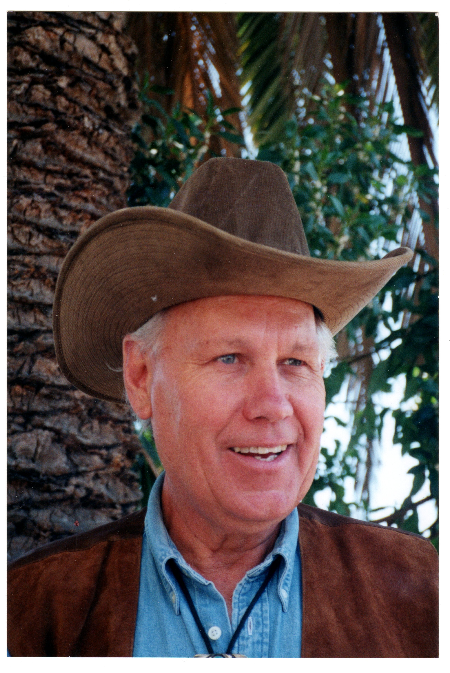The Old West Thrives in Big Jim’s Imagination
A Western Writer Weaves Fact and Fiction to Capture a Vanished Way of Life
It’s no exaggeration to call the affable, 6’2″-tall writer “Big Jim” Williams, but the retired Santa Barbara City College public relations officer and radio journalist also enjoys an expansive imagination that feels at home in the Old West. It is where his fiction took root and has flourished in print, online, in two audiobooks, and in radio dramas.

Since 1998, when he sold and published his first short story—titled “Buckshot’s Thanksgiving”—Williams has written in different genres, such as science fiction and suspense, but he is most happy to be identified as a Western writer.
“I love Western history and have read a great deal of it,” he said. “As a result, I’ve always admired the people of the Western movement, their tenacity, courage, and resourcefulness.” The suffering of the settlers and adventurers who took the Oregon Trail or crossed the deserts to California can be measured by the graves of those who did not make it, he noted.
In his Goleta home office, Williams commands a computer that is surrounded by shelves stuffed with resource books and travel and writing mementos and decorated by bronze busts of cowboys he sculpted himself. A separate room houses the personal library he and his wife, Joan, have accumulated over the years. She also is a published writer and has won the top prize in an area story contest, he said.
Most of Williams’s writing for radio—he continues to write and reads Community Calendar items for Santa Barbara radio station KZSB 15 times a month—and for City College was nonfiction. After retiring from academe he turned with renewed vigor to creating fictional short stories, most with Western themes and settings.
It took six years of submissions before Western Horseman magazine anointed him a professional fiction writer. “I was really tickled to be able to sell (them a story),” he recalled.
“I was 66 when I sold that one, so I’m not a young starter,” quipped Williams. Thinking he had finally achieved market access, he submitted two or three other stories to the same magazine. All were rejected. But it would take more than a few rejections to dissuade Big Jim Williams.
And he found a way to recover lost ground in building his fiction

Confident he could spin marketable yarns, he cranked them out, honing his craft and perfecting his timing by alternating drama and comedy. When he sold one, he retained the copyright, allowing him to reuse the material. That is why his short stories can be found in anthologies and audiobooks as well as the original magazine or online publication.
To sample Big Jim’s Western stories go to the Rope and Wire’s Web site. There, one can meet Buckshot Jones—midwife to Williams’s career in fiction—in the comic but cautionary “Buckshot’s Mail-Order Bride” as well as a serious study of how a solitary man survives winter and wolves in “The Last Mountain Man.”
A human-against-the-elements account, “Mountain Man” mixes factual descriptions of 1840s gear, alpine weather, and survival tactics with some invented wolf behavior for drama. This blend of fact and fiction has worked well for Williams, but he still marvels that “once you give a character his head, they take over a story.”
Williams’s yarns have been collected in two audiobooks, The Old West and Tall Tales of the Old West, with the author narrating the latter. A reviewer of Tall Tales noted that one of the Western stories had “a Twilight Zone twist,” and Williams cheerfully acknowledged the influence.
“I like to write stories with twists,” he said, adding that two of his favorite authors, Mark Twain and O. Henry, inserted unexpected behavior or events to surprise readers. Rod Serling’s Twilight Zone series is the 20th-century television equivalent of the two 19th-century authors in Williams’s pantheon of literary models.
Ironic twists often surface in Williams’s fiction, though he may not always plan their appearances. The technique he uses in his storytelling, which he usually begins around 6 a.m., is “to take a situation and start writing.” He doesn’t outline the action or characters; he imagines the scene and the characters in it and “plays with it, sees what develops. It’s more fun than writing a press release,” he deadpanned.
Such approaches and experiences are among the writing tips Williams planned to share at the end of March, when he and five other authors joined forces for Authors’ Day in Sacramento. Hosted by the regional chapter of the Assistance League, the theme of the daylong gathering was “Can You Dig It: Unearthing California’s Legends and Lore.”
It sounded as if Big Jim had found the right audience.



